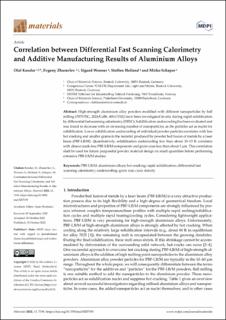| dc.contributor.author | Kessler, Olaf | |
| dc.contributor.author | Zhuralev, Evgeny | |
| dc.contributor.author | Wenner, Sigurd | |
| dc.contributor.author | Heiland, Steffen | |
| dc.contributor.author | Shaper, Mirko | |
| dc.date.accessioned | 2022-10-18T10:09:56Z | |
| dc.date.available | 2022-10-18T10:09:56Z | |
| dc.date.created | 2022-10-17T08:14:59Z | |
| dc.date.issued | 2022 | |
| dc.identifier.citation | Materials, 2022,15(20), 7195, 1-11. | en_US |
| dc.identifier.issn | 1996-1944 | |
| dc.identifier.uri | https://hdl.handle.net/11250/3026596 | |
| dc.description.abstract | High-strength aluminium alloy powders modified with different nanoparticles by ball milling (7075/TiC, 2024/CaB6, 6061/YSZ) have been investigated in-situ during rapid solidification by differential fast scanning calorimetry (DFSC). Solidification undercooling has been evaluated and was found to decrease with an increasing number of nanoparticles, as the particles act as nuclei for solidification. Lower solidification undercooling of individual powder particles correlates with less hot cracking and smaller grains in the material produced by powder bed fusion of metals by a laser beam (PBF-LB/M). Quantitatively, solidification undercooling less than about 10–15 K correlates with almost crack-free PBF-LB/M components and grain sizes less than about 3 µm. This correlation shall be used for future purposeful powder material design on small quantities before performing extensive PBF-LB/M studies. | en_US |
| dc.language.iso | eng | en_US |
| dc.publisher | MDPI | en_US |
| dc.rights | Navngivelse 4.0 Internasjonal | * |
| dc.rights.uri | http://creativecommons.org/licenses/by/4.0/deed.no | * |
| dc.subject | crack density | en_US |
| dc.subject | grain size | en_US |
| dc.subject | undercooling | en_US |
| dc.subject | differential fast scanning calorimetry | en_US |
| dc.subject | rapid solidification | en_US |
| dc.subject | hot cracking | en_US |
| dc.subject | aluminium alloys | en_US |
| dc.subject | PBF-LB/M | en_US |
| dc.title | Correlation between Differential Fast Scanning Calorimetry and Additive Manufacturing Results of Aluminium Alloys | en_US |
| dc.title.alternative | Correlation between Differential Fast Scanning Calorimetry and Additive Manufacturing Results of Aluminium Alloys | en_US |
| dc.type | Peer reviewed | en_US |
| dc.type | Journal article | en_US |
| dc.description.version | publishedVersion | en_US |
| dc.rights.holder | Copyright: © 2022 by the authors. Li‐ censee MDPI, Basel, Switzerland. This article is an open access article distributed under the terms and con‐ ditions of the Creative Commons At‐ tribution (CC BY) license (https://cre‐ ativecommons.org/licenses/by/4.0/). | en_US |
| dc.source.pagenumber | 11 | en_US |
| dc.source.volume | 15 | en_US |
| dc.source.journal | Materials | en_US |
| dc.source.issue | 20 | en_US |
| dc.identifier.doi | 10.3390/ma15207195 | |
| dc.identifier.cristin | 2061802 | |
| dc.relation.project | Norges forskningsråd: 245963 | en_US |
| dc.relation.project | NORTEM: 197405 | en_US |
| dc.source.articlenumber | 7195 | en_US |
| cristin.ispublished | true | |
| cristin.fulltext | original | |
| cristin.qualitycode | 1 | |

